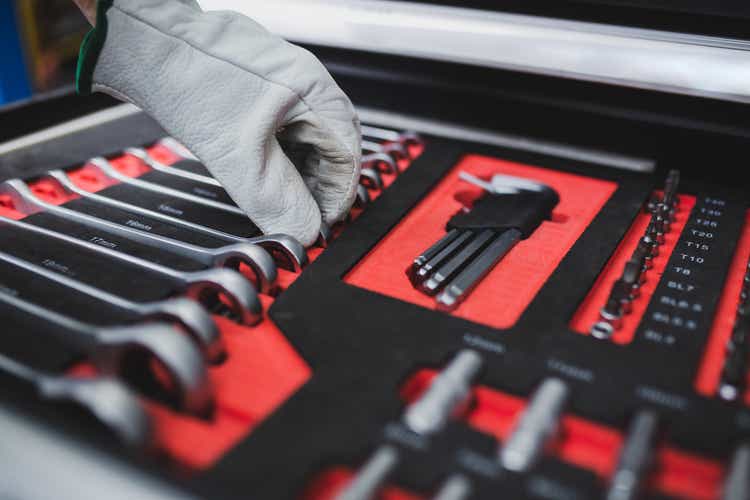iantfoto/E+ via Getty Images
Snap-on (NYSE:SNA) surfaced on my radar again as shares have appeared on the list of stock which have set a 52-week low. This in itself is enough of a reason to update a thesis which goes back a long way, the summer of 2017 to be more precise.
Over the past five years the company has seen solid revenue growth as it maintained margins. With shares underperforming a bit, the multiples have compressed quite a bit, while the balance sheet has been strengthened along the way.
Back To 2017
Five years ago I concluded that the market was rightfully discounting the margins posted by Snap-on at the time, with the market skeptical about peak margins, driven by the financing unit and rapid growth in financing receivables.
At the time, shares of the company traded at just around 15 times earnings, a discount versus the market and peers. This is despite a strong track record with the company having paid out uninterrupted dividends since 1939 by focusing its business on precision, performance and pride.
The company is largely focused on its namesake tools group for vehicle repairs, as repair systems and information group (vehicle repair shops) and commercial and industrial group (professional in other industries) each make up nearly a third of sales. Aging and increased complexity of cars makes that hand tools, diagnostics, power tools and other products of the company are on the rise, but in all honesty I was not too compelled.
After all, the company had ¨only¨ grown sales from $2.7 billion in 2007 to $3.5 billion in 2017, working down to a modest 2% revenue growth per annum, being largely in line with inflation. Operating margins have doubled from the low teens towards 25% of sales on the back of pricing, cost-cutting and financing operations, an activity which rose rapidly and reported a loan book of $2 billion in 2017.
Hence, I was not too compelled with the topline growth and the quality of the business. With shares trading at $150 in the summer of 2017, valuations were reasonable with earnings power pegged at $10 per share. On the other hand, net debt stood at a billion, which was manageable with EBITDA trending around the same number, although leverage ratios did come in higher if we factor in the risks on the loan book, as well as including some pension liabilities as well.
Believing the 25% operating margins were too high and margins around 20% would be more sustainable, I pegged sustainable earnings power at around $7.50 per share, leaving me interested at $130 per share.
Caution Saves The Day
Since the summer of 2017, shares have actually been trading at around the $150-$200 ranges until the start of the pandemic. After an initial dip shares rallied back to the range by year´s end, to hit a high of around $250 in spring of 2021, now having settled at $200 again. Save to say that 30% cumulative returns over a five-year period are not too inspiring, albeit that the company pays out a fair dividend of nearly 3% here.
Fast forwarding to early 2022 the company has seen further growth as revenues rose from $3.6 billion in 2020 (revenues in line with 2017) to nearly $4.3 billion in 2021. Including financial revenues, total revenues have come in at $4.6 billion. Net earnings jumped from $627 million to $820 million, as earnings per share rose from roughly $11.50 per share to $15 per share, marking 50% growth from 2017. Moreover, net debt has been cut to $419 million, while the loan book has been rather stable in terms of its size.
The company did not provide an official guidance for 2022, but sounded upbeat given growth in some end markets and focus on adjacent markets. Based on earnings power around $15 per share, valuation multiples are still very modest, at 13-14 times to be precise as margins continue to come in the mid-twenties. At these valuations, we see multiple compression versus 2017 while the balance sheet has gradually become healthier, with net debt down substantially. Given the macro environment, I would be happy if the company would be able to post flattish earnings this year, but time will tell.
Over the past five years the company has delivered on solid topline sales growth, margins have been stable, valuations have compressed, and the balance sheet has only improved. All of this makes me quite upbeat here as Snap-on is still a solid business, with investors perhaps concerned that some of its tools will be in less demand with electrification of course. The counterargument might be true as well, as more sensor and autonomous driving efforts might increase demand for the diagnostics tools of the business as well.
Holding A Stake
With the dividend yield rapidly increasing towards the 3% mark, amidst continued share price stagnation and higher dividends, I see appeal emerging. Hence, I have initiated a modest position here, as Snap-on has a great (dividend) track record as well, built up over many decades. While I did not expect spectacular near to medium term results, the risk-reward here seems compelling enough to hold a position with reasonable expectations in the medium term.


Be the first to comment